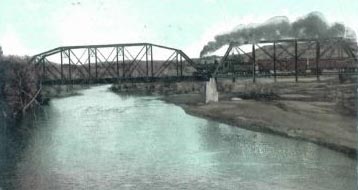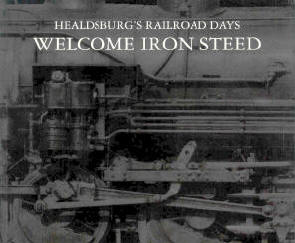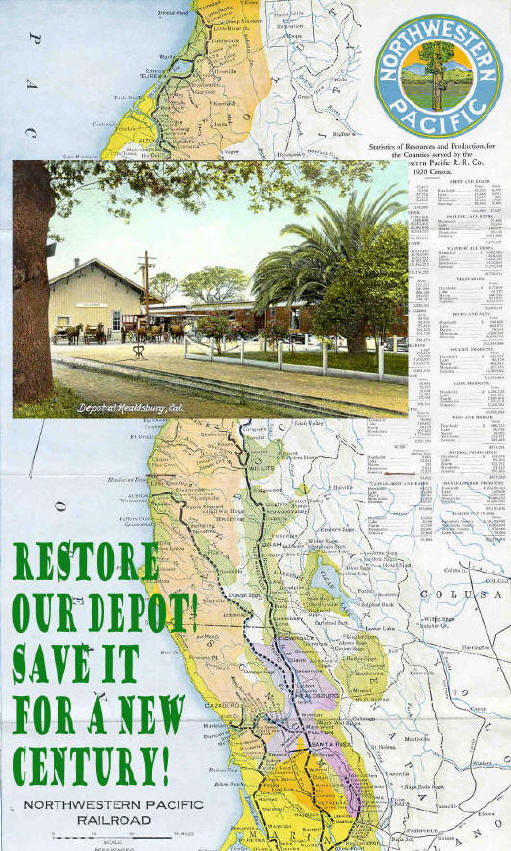|
 click to enlarge images
click to enlarge images
The big surprise of
the 1998 Smithsonian Art Train Celebration at the Healdsburg Depot is that the
Depot was more interesting than the Art Train.
103102_small.JPG) The Celebration had been in preparation for months, with arrangements for the
arrival and location of antique railroad cars, the diverting and placement of
the Art Train, event planning and publicity, community fundraising and support.
But the most extensive, and the most involving work concerned the depot itself.
The Celebration had been in preparation for months, with arrangements for the
arrival and location of antique railroad cars, the diverting and placement of
the Art Train, event planning and publicity, community fundraising and support.
But the most extensive, and the most involving work concerned the depot itself.

Originally built in
1873, the main building had been in use until the shutdown of the Northwestern
Pacific Railroad in the early 1990s. Built of massive redwood beams, it had
survived not only the massive 1906 earthquake--the largest recorded seismic
shock on the world's largest earthquake fault---but all subsequent and lesser
tremors. The interior was a treasure-trove of old-time railroad architecture
and old-time hobo graffiti: SWEDE ISBERG, 1917, one grassroots calligrapher
memorialized himself.
To meet contemporary
earthquake standards, the building had to have a concrete foundation. So, with
donated financial support, the building was jacked up and a full foundation was
poured. Stairways were built with railings and adequate handicapped access.
The grounds were cleaned up, the weeds chopped, the broken glass and refuse
hauled away. During this process, the community response was amazing. People
on the way to Healdsburg Lumber would stop by, pick up a shovel or a broom and
pitch in. Drivers came by with plants they were donating to brighten up the
place. The building's eaves were festooned with a string of lights. The
long-shuttered depot became once again a center of community activity.
A number of events were
held in the building, centered around the Art Train. There was an outdoor
concert, with the audience sitting on hay bales, where bluegrass bands, the
Healdsburg Community Band and the Community Chorus performed. There was a
Children's Art Show, in the main building, with the freight door rolled back and
daylight streaming in, that was wonderful. Local kids had assembled "family
ties", woven assemblages of personal mementos that were hung from the rafters of
the freight room. For imagination and playfulness, the show surpassed anything
on the Art Train itself.
In the same room, the
following night, the Fitch Mountain Players staged a performance. It was cold
out, and the room was warmed with heat lamps, but the play, an historical drama
about the town, took on the authentic aura of the depot. The following night,
the depot was transformed into a teenage disco. The adaptability of the
building, the economy of its transformation, and the speed of the turnarounds,
sent an unmistakable message: this place was a potentially priceless community
asset.

All kinds of plans
were rumored. The Northwestern Pacific was going to relocate its museum to the
depot. A cafe was going to open in the adjoining ticket building. The freight
building was going to be Healdsburg's Performing Arts Center. Then something
happened. The Art Train left, and Healdsburg's civic attention turned
elsewhere. It was said that the building had failed to meet contemporary quake
safety standards, and that the drive to refurbish had fallen some $50,000
short. But the truth seems to be that the community attention span had sadly
moved on.
So there the depot
now sits, as it has for so many years, an ignored and neglected community
asset. The weeds have grown back, broken glass once again litters the parking
lot and tracks, homeless people and cranksters occasionally break in, tag the
walls, start fires. Attention is elsewhere. There are plans for a bus
turnaround, for a revival of the NWP, lots of talk, but so far little action.
Meanwhile, commercial
developers are hovering. The depot is the last site in Healdsburg offering a
full vista from the river to the east to the forests in the west. It is
temptingly level and centrally located. The thought of a mall or townhouse
complex located here must make the entrepreneurial heart pound. Sooner or
later, this part of town will be redeveloped. It is inevitable. The question
is, will it be for the benefit of a few people, and a commercial developer's
short-term gain, or for the community of Healdsburg, now and for the enrichment
of life for generations of local people to come?
John van der Zee
John van der Zee lives in Healdsburg. His books include:
"Agony in the Garden", "The Gate, The True Story of the Design and Construction
of the Golden Gate Bridge", "Bound Over: Indentured Servitude and American
Conscience", "The Imagined City: San Francisco in the Minds of its Writers",
“Canyon: the story of the last rustic community in metropolitan America” and
"The Greatest Men's Party on Earth -- Inside the Bohemian Grove", among others.
John was involved in the refurbishing of the Healdsburg
Depot at the time of the Art Train celebration in 1998. He researched and wrote
the book WELCOME IRON STEED, about the town's railroad history, and donated his
share of proceeds to the restoration of the Depot.

1907 morning at the Northwester Pacific
Healdsburg depot. (below)
|

![]()